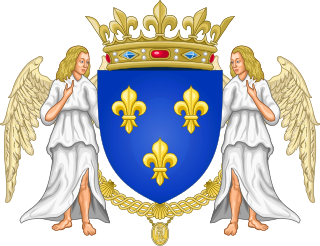
The Capetian house of Valois was a cadet branch of the Capetian dynasty. They succeeded the House of Capet to the French throne, and were the royal house of France from 1328 to 1589. Junior members of the family founded cadet branches in Orléans, Anjou, Burgundy, and Alençon.

John of Lancaster, Duke of Bedford KG was a medieval English prince, general and statesman who commanded England's armies in France during a critical phase of the Hundred Years' War. Bedford was the third son of King Henry IV of England, brother to Henry V, and acted as regent of France for his nephew Henry VI. Despite his military and administrative talent, the situation in France had severely deteriorated by the time of his death.
The Treaty of Troyes was an agreement that King Henry V of England and his heirs would inherit the French throne upon the death of King Charles VI of France. It was formally signed in the French city of Troyes on 21 May 1420 in the aftermath of Henry's successful military campaign in France. It forms a part of the backdrop of the latter phase of the Hundred Years' War finally won by the French at the Battle of Castillon in 1453, and in which various English kings tried to establish their claims to the French throne.

Pierre Cauchon was a French Catholic prelate who served as Bishop of Beauvais from 1420 to 1432. He was a strong partisan of English interests in France during the latter years of the Hundred Years' War. He was the judge in the trial of Joan of Arc and played a key role in her execution. The Catholic Church overturned his verdict in 1456.
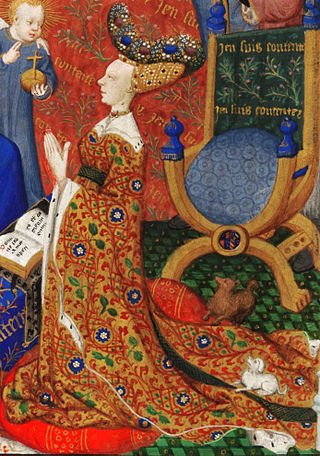
Anne of Burgundy, Duchess of Bedford was a daughter of John the Fearless, Duke of Burgundy (1371–1419), and his wife Margaret of Bavaria (1363–1423).

Philip III was Duke of Burgundy from 1419 until his death. He was a member of a cadet line of the Valois dynasty, to which all 15th-century kings of France belonged. During his reign, the Burgundian State reached the apex of its prosperity and prestige, and became a leading centre of the arts.
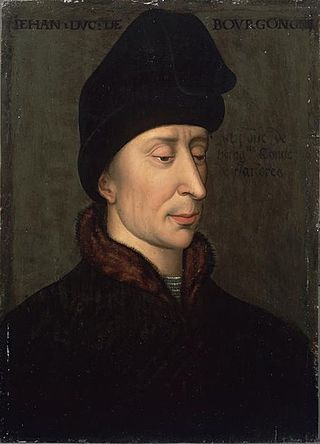
John I was a scion of the French royal family who ruled the Burgundian State from 1404 until his death in 1419. He played a key role in French national affairs during the early 15th century, particularly in the struggles to rule the country for the mentally ill King Charles VI, his cousin, and the Hundred Years' War with England. A rash, ruthless and unscrupulous politician, John murdered the King's brother, the Duke of Orléans, in an attempt to gain control of the government, which led to the eruption of the Armagnac–Burgundian Civil War in France and in turn culminated in his own assassination in 1419.
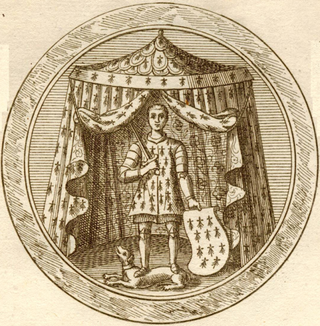
John V, sometimes numbered as VI, bynamed John the Wise, was Duke of Brittany and Count of Montfort from 1399 to his death. His rule coincided with the height of the Hundred Years' War between England and France. John's reversals in that conflict, as well as in other internal struggles in France, served to strengthen his duchy and to maintain its independence.

Arthur III, more commonly known as Arthur de Richemont, was briefly Duke of Brittany from 1457 until his death. He is noted primarily, however, for his role as a leading military commander during the Hundred Years' War. Although Richemont briefly sided with the English once, he otherwise remained firmly committed to the House of Valois. He fought alongside Joan of Arc, and was appointed Constable of France. His military and administrative reforms in the French state were an important factor in assuring the final defeat of the English in the Hundred Years' War.
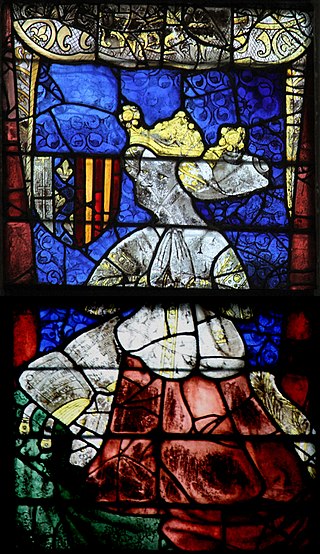
Yolande of Aragon was Duchess of Anjou and Countess of Provence by marriage, who acted as regent of Provence during the minority of her son. She was a daughter of John I of Aragon and his wife Violant of Bar. Yolande played a crucial role in the struggles between France and England, influencing events such as the financing of Joan of Arc's army in 1429 that helped tip the balance in favour of the French. She was also known as Yolanda de Aragón and Violant d'Aragó. Tradition holds that she commissioned the famous Rohan Hours.

The Burgundian party was a political allegiance against France that formed during the latter half of the Hundred Years' War. The term "Burgundians" refers to the supporters of the Duke of Burgundy, John the Fearless, that formed after the assassination of Louis I, Duke of Orléans. Their opposition to the Armagnac party, the supporters of Charles, Duke of Orléans, led to a civil war in the early 15th century, itself part of the larger Hundred Years' War.

The Congress of Arras was a diplomatic congregation established at Arras in the summer of 1435 during the Hundred Years' War, between representatives of England, France and Burgundy. It was the first negotiation since the Treaty of Troyes and replaced the fifteen-year agreement between Burgundy and England that would have seen the dynasty of Henry V inherit the French crown. Historian Richard Vaughan has called it "Europe's first real peace congress."

The Treaty of Picquigny was a peace treaty negotiated on 29 August 1475 between the Kingdom of England and the Kingdom of France. It followed from an invasion of France by Edward IV of England in alliance with Burgundy and Brittany. It left Louis XI of France free to solve the threat posed by Charles the Bold, Duke of Burgundy.

The Lancastrian War was the third and final phase of the Hundred Years' War between England and France. It lasted from 1415, when King Henry V of England invaded Normandy, to 1453, when the English lost Bordeaux. It followed a long period of peace from the end of the Caroline War in 1389. The phase is named after the House of Lancaster, the ruling house of the Kingdom of England, to which Henry V belonged.

Margaret of Nevers, also known as Margaret of Burgundy, was Dauphine of France and Duchess of Guyenne as the daughter-in-law of King Charles VI of France. A pawn in the dynastic struggles between her family and in-laws during the Hundred Years' War, Margaret was regarded as the future Queen of France at two separate times, as a result of her two marriages: first to the Dauphin and second to the Duke of Brittany.

The House of Valois-Burgundy, or the Younger House of Burgundy, was a noble French family deriving from the royal House of Valois. It is distinct from the Capetian House of Burgundy, descendants of King Robert II of France, though both houses stem from the Capetian dynasty. They ruled the Duchy of Burgundy from 1363 to 1482 and later came to rule vast lands including Artois, Flanders, Luxembourg, Hainault, the county palatine of Burgundy (Franche-Comté), and other lands through marriage, forming what is now known as the Burgundian State.
Events from the 1420s in England.
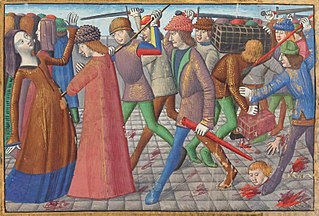
The Armagnac–Burgundian Civil War was a conflict between two cadet branches of the French royal family – the House of Orléans and the House of Burgundy from 1407 to 1435. It began during a lull in the Hundred Years' War against the English and overlapped with the Western Schism of the papacy.

The dual monarchy of England and France existed during the latter phase of the Hundred Years' War when Charles VII of France and Henry VI of England disputed the succession to the throne of France. It commenced on 21 October 1422 upon the death of King Charles VI of France, who had signed the Treaty of Troyes which gave the French crown to his son-in-law Henry V of England and Henry's heirs. It excluded King Charles's son, the Dauphin Charles, who by right of primogeniture was the heir to the Kingdom of France. Although the Treaty was ratified by the Estates-General of France, the act was a contravention of the French law of succession which decreed that the French crown could not be alienated. Henry VI, son of Henry V, became king of both England and France and was recognized only by the English and Burgundians until 1435 as King Henry II of France. He was crowned King of France on 16 December 1431.

The Burgundian State is a concept coined by historians to describe the vast complex of territories that is also referred to as Valois Burgundy.

















